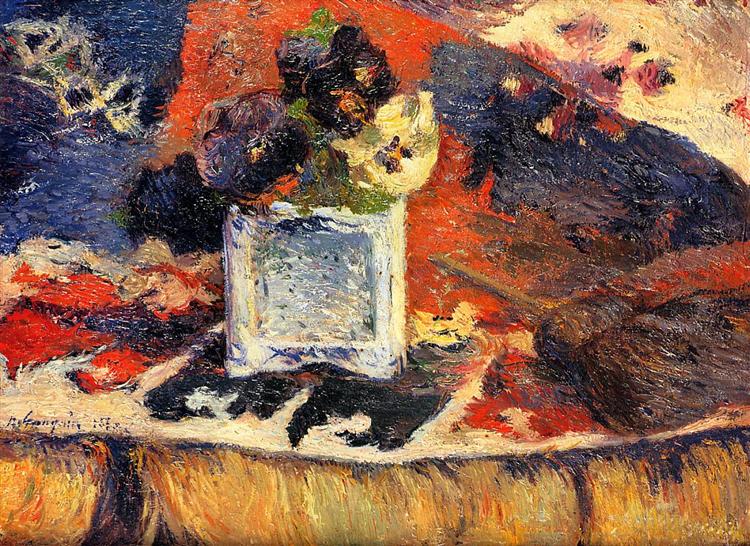描述
In "Flowers and Carpet (Pansies)", created in 1880, Paul Gauguin offers us a work that encapsulates his search for a vibrant and decorative aesthetic, which transcends the simple representation of nature. This painting is a clear precursor of the style that the artist would perfect in his later works, where the combination of color, shape and an almost symbolic approach become unavoidable protagonists.
Visually, the work is structured around an almost weightless treatment of the composition. The flowers, depicted in an almost stylised manner, appear arranged on a background reminiscent of a decorative carpet, characterised by its rich texture and geometric patterns. The flowers, especially the pansies, emerge with intense colouring that contrasts sharply with the dark background, creating a kind of relief that catches the viewer's eye. The use of pure, saturated colours is a distinctive feature of Gauguin's work, who, at this stage of his career, was beginning to explore the emotionality of colour as a form of expression rather than as a means of realistically reflecting reality.
Gauguin presents the flowers in an almost ornamental treatment, where the details seem to underline the essence of each of the natural elements, moving away from strict naturalism. This is evident in the softness of the contours and the way the colours blend and contrast, evoking a sense of harmony that transcends mere observation. The way the flowers are arranged in the image creates a dialogue between them, suggesting movement, while the repetition of the shapes adds a pattern that could almost remind us of the tradition of tapestries.
The absence of human figures in this work highlights Gauguin's attention to the interrelationship of natural elements, suggesting a deeper connection between nature and the viewer. This depiction of flowers, far from being simply decorative, invites introspective and reflective contemplation, a recurring theme in Gauguin's art, which often sought to give voice to what he considered the essence of the human being in connection with the natural environment.
This painting is also representative of Gauguin's evolution towards a more symbolic style in his later career, which would be most evident in his later works in Tahiti. "Flowers and Carpet" can be seen as a first step towards the exploitation of colour, symbolism and emotion that would become a hallmark of his art. It is a work that, although discreet and far from the grandiosity of his later compositions, shows the beginning of a deep exploration into the meaning of colour and form.
Thus, "Flowers and Carpet (Pansies)" is not only a portrait of the beauty of nature, but also an invitation to reflect on perception and experience. Through his technique and his masterful use of color, Gauguin invites us to immerse ourselves in a world where aesthetics becomes a vehicle of meaning and emotional connection, laying the foundations for his legacy in the history of art.
KUADROS ©, a famous painting on your wall.
Hand-made oil painting reproductions, with the quality of professional artists and the distinctive seal of KUADROS ©.
Painting reproduction service with satisfaction guarantee. If you are not completely satisfied with the replica of your painting, we will refund 100% of your money.

